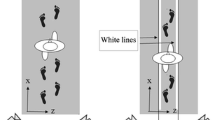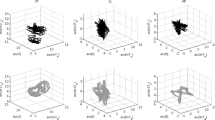Abstract
We investigated how subjects with cerebellar ataxia (CA) adapt their postural stability and alignment to a slow and small tilt of the support surface allowing for online postural corrections. Eight subjects with CA and eight age- and gender-matched healthy control subjects participated in the study. Subjects stood eyes closed for 1 min after which the support surface was tilted 5° toes-up at a ramp velocity of 1°/s. The toes-up position was held for 2.5 min after which the surface rotated back down to level with identical tilt characteristics. As reflected by the large number of falls, subjects with CA had marked difficulty adapting their posture to the up-moving incline in contrast to control subjects. Subjects with CA who lost their balance had faster trunk velocity and excessive backward trunk reorientation beginning within the first second after onset of the tilting surface. In contrast, the down-moving tilt to level did not result in instability in CA subjects. These results suggest that instability and falls associated with CA derive from an inability to maintain trunk orientation to vertical while standing on a slow-moving or unstable surface. This study underscores the importance of the cerebellum in the online sensory control of the upper body orientation during small amplitude and slow velocity movements of the support surface.


Similar content being viewed by others
Abbreviations
- ABC:
-
Activities-specific Balance Confidence scale
- BESTest:
-
Balance Evaluation Systems Test
- CA:
-
Cerebellar ataxia
- COM:
-
Center of mass
- COP:
-
Center of pressure
- DTR:
-
Deep tendon reflex
- LOB:
-
Loss of balance
- MSA-C:
-
Multiple system atrophy cerebellar dysfunction subtype
- SAOA:
-
Sporadic adult-onset ataxia
- SARA:
-
Scale for the assessment and rating of ataxia
- SCA:
-
Spinocerebellar ataxia
References
van de Warrenburg BP, Steijns JA, Munneke M, Kremer BP, Bloem BR. Falls in degenerative cerebellar ataxias. Mov Disord. 2005;20:497–500.
Fonteyn EM, Schmitz-Hubsch T, Verstappen CC, Baliko L, Bloem BR, Boesch S, et al. Falls in spinocerebellar ataxias: Results of the EuroSCA Fall Study. Cerebellum. 2010;9:232–9.
Baloh RW, Jacobson KM, Beykirch K, Honrubia V. Static and dynamic posturography in patients with vestibular and cerebellar lesions. Arch Neurol. 1998;55:649–54.
Bakker M, Allum JH, Visser JE, Gruneberg C, van de Warrenburg BP, Kremer BH, et al. Postural responses to multidirectional stance perturbations in cerebellar ataxia. Exp Neurol. 2006;202:21–35.
Kung UM, Horlings CG, Honegger F, Kremer HP, Bloem BR, van De Warrenburg BP, et al. Postural instability in cerebellar ataxia: correlations of knee, arm and trunk movements to center of mass velocity. Neuroscience. 2009;159:390–404.
Oude Nijhuis LB, Hegeman J, Bakker M, Van Meel M, Bloem BR, Allum JH. The influence of knee rigidity on balance corrections: a comparison with responses of cerebellar ataxia patients. Exp Brain Res. 2008;187:181–91.
Horak FB, Diener HC. Cerebellar control of postural scaling and central set in stance. J Neurophysiol. 1994;72:479–93.
Diener HC, Dichgans J, Bacher M, Guschlbauer B. Characteristic alterations of long-loop "reflexes" in patients with Friedreich's disease and late atrophy of the cerebellar anterior lobe. J Neurol Neurosurg Psychiatry. 1984;47:679–85.
Kawato M. Internal models for motor control and trajectory planning. Curr Opin Neurobiol. 1999;9:718–27.
Wolpert DM, Ghahramani Z, Jordan MI. An internal model for sensorimotor integration. Science. 1995;269:1880–2.
Day BL, Thompson PD, Harding AE, Marsden CD. Influence of vision on upper limb reaching movements in patients with cerebellar ataxia. Brain. 1998;121(Pt 2):357–72.
Kluzik J, Horak FB, Peterka RJ. Differences in preferred reference frames for postural orientation shown by after-effects of stance on an inclined surface. Exp Brain Res. 2005;162:474–89.
Schmitz-Hubsch T, du Montcel ST, Baliko L, Berciano J, Boesch S, Depondt C, et al. Scale for the assessment and rating of ataxia: development of a new clinical scale. Neurology. 2006;66:1717–20.
Allum JH, Honegger F, Pfaltz CR. The role of stretch and vestibulo-spinal reflexes in the generation of human equilibrating reactions. Prog Brain Res. 1989;80:399–409.
Beckley DJ, Bloem BR, Remler MP, Roos RA, Van Dijk JG. Long latency postural responses are functionally modified by cognitive set. Electroencephalogr Clin Neurophysiol. 1991;81:353–8.
Diener HC, Horak FB, Nashner LM. Influence of stimulus parameters on human postural responses. J Neurophysiol. 1988;59:1888–905.
Henry SM, Fung J, Horak FB. Control of stance during lateral and anterior/posterior surface translations. IEEE Trans Rehabil Eng. 1998;6:32–42.
Nashner LM. Fixed patterns of rapid postural responses among leg muscles during stance. Exp Brain Res. 1977;30:13–24.
Horak FB, Nashner LM. Central programming of postural movements: adaptation to altered support-surface configurations. J Neurophysiol. 1986;55:1369–81.
Soucie JM, Wang C, Forsyth A, Funk S, Denny M, Roach KE, et al. Range of motion measurements: reference values and a database for comparison studies. Haemophilia. 2011;17:500–7.
Jonsson E, Henriksson M, Hirschfeld H. Does the functional reach test reflect stability limits in elderly people? J Rehabil Med. 2003;35:26–30.
Welch TD, Ting LH. A feedback model explains the differential scaling of human postural responses to perturbation acceleration and velocity. J Neurophysiol. 2009;101:3294–309.
Earhart GM, Bastian AJ. Selection and coordination of human locomotor forms following cerebellar damage. J Neurophysiol. 2001;85:759–69.
Van de Warrenburg BP, Bakker M, Kremer BP, Bloem BR, Allum JH. Trunk sway in patients with spinocerebellar ataxia. Mov Disord. 2005;20:1006–13.
Diener HC, Dichgans J, Bacher M, Gompf B. Quantification of postural sway in normals and patients with cerebellar diseases. Electroencephalogr Clin Neurophysiol. 1984;57:134–42.
Mauritz KH, Schmitt C, Dichgans J. Delayed and enhanced long latency reflexes as the possible cause of postural tremor in late cerebellar atrophy. Brain. 1981;104:97–116.
Acknowledgments
The authors thank Cristiane Zampieri and Kelly Bartow for their help with data collection as well as Triana Nagel for her help in the subject recruitment and data collection. This research was supported by the NIH R01-DC004082 and NIH R37-AG006457.
Conflict of interest
None of the authors have any financial and personal relationships that might bias the work presented in the current manuscript.
Author information
Authors and Affiliations
Corresponding author
Rights and permissions
About this article
Cite this article
Paquette, C., Franzén, E. & Horak, F.B. More Falls in Cerebellar Ataxia When Standing on a Slow Up-Moving Tilt of the Support Surface. Cerebellum 15, 336–342 (2016). https://doi.org/10.1007/s12311-015-0704-6
Published:
Issue Date:
DOI: https://doi.org/10.1007/s12311-015-0704-6




